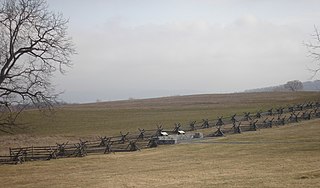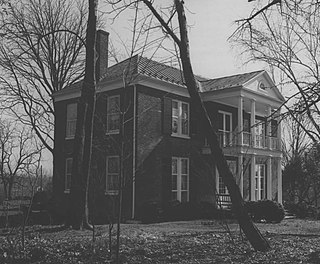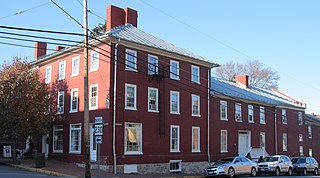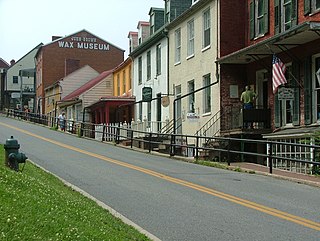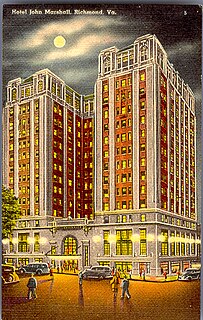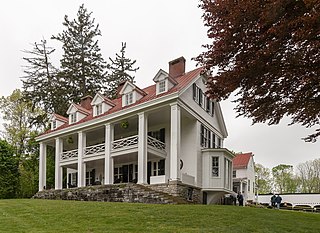Shepherdstown Historic District | |
German Street | |
| Location | Shepherdstown, West Virginia |
|---|---|
| Coordinates | 39°25′58″N77°48′24″W / 39.43278°N 77.80667°W Coordinates: 39°25′58″N77°48′24″W / 39.43278°N 77.80667°W |
| Architect | Unknown |
| Architectural style | Federal |
| NRHP reference # | 73001920, 87001205 |
| Added to NRHP | August 17, 1973, expanded July 22, 1987 [1] |
The Shepherdstown Historic District comprises the historic core of Shepherdstown, West Virginia. The town is the oldest in West Virginia, founded in 1762 as Mecklenburg. No structures are known to exist from the time before the town became known as Shepherdstown. The historic district is concentrated along German Street, the main street, with 386 contributing resources and 69 non-contributing elements. The chief representative period is the late 18th century, with many Federal style brick houses. German Street is also furnished with 19th-century "street furniture" such as metal fences, mounting blocks, wooden pumps and mature trees.

Shepherdstown is a town in Jefferson County, West Virginia, in the United States, located in the lower Shenandoah Valley along the Potomac River. Home to Shepherd University, the town's population was 1,734 at the 2010 census.
The town has a significant place in American history. James Rumsey made a public demonstration of a steamboat in 1787 on the nearby Potomac River. Shepherdstown was proposed as the National Capital in 1790, losing to Alexandria, Virginia, and Georgetown, Maryland, at the tidal headwaters of the Potomac. During the Civil War, Shepherdstown was in a pivotal position, with Confederate forces burning the covered bridge over the Potomac in 1861, then using nearby Pack Horse Ford to and from the Battle of Antietam. The entire town became a field hospital following this action. Later, Union troops occupied the town to preserve the Baltimore and Ohio Railroad link to the west.

James Rumsey (1743–1792) was an American mechanical engineer chiefly known for exhibiting a boat propelled by machinery in 1787 on the Potomac River at Shepherdstown in present-day West Virginia before a crowd of local notables, including Horatio Gates. A pump driven by steam power ejected a stream of water from the stern of the boat and thereby propelled the boat forward.

A steamboat is a boat that is propelled primarily by steam power, typically driving propellers or paddlewheels. Steamboats sometimes use the prefix designation SS, S.S. or S/S or PS, however these designations are most often used for steamships.

The Potomac River is located within the Mid-Atlantic region of the United States and flows from the Potomac Highlands into the Chesapeake Bay. The river is approximately 405 miles (652 km) long, with a drainage area of about 14,700 square miles (38,000 km2). In terms of area, this makes the Potomac River the fourth largest river along the Atlantic coast of the United States and the 21st largest in the United States. Over 5 million people live within the Potomac watershed.
Some of the more significant elements are:
- Baker House, a Federal style brick house with a Roman Revival porch, dating to the 1790s. It was the home of US Representative John Baker.
- The Great Western Hotel, owned by Jacob Entler. Originally a log structure, it was extensively modified in the early 19th century.
- The Presbyterian Manse, a brick Federal style or Classical Revival house, home of John Kearsley, a prominent local landowner.
- Trinity Episcopal Rectory, a Federal style house that was a home of John Baker, as well as US Representative Thomas Van Swearingen.
- The Lane House, a Federal style house once owned by Harriet Lane, niece and hostess for President James Buchanan.
- The Sheetz House, a Federal style house where muskets were manufactured during the American Revolutionary War.
- The Old Market House, the town's former market built in 1800, with stepped gable ends. A second story was added in 1845 by the Odd Fellows with a 999-year lease. The first floor has been a public library since 1922.
John Baker was an American politician who represented Virginia in the United States House of Representatives from 1811 to 1813.
Thomas Van Swearingen was a U.S. Representative from Virginia.
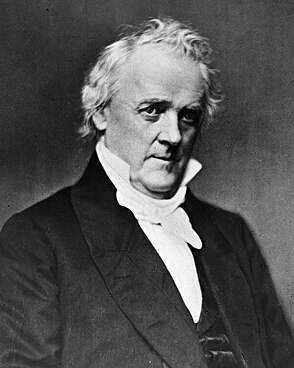
James Buchanan Jr. was an American politician who served as the 15th president of the United States (1857–1861), serving immediately prior to the American Civil War. A member of the Democratic Party, he was the 17th United States secretary of state and had served in the Senate and House of Representatives before becoming president.

- McMurran Hall, a yellow brick Greek Revival building in the Corinthian order, which served as the Jefferson County Courthouse immediately after the American Civil War. It was later the first building used by Shepherd College.
- The Entler Hotel , a thirty-two room complex, which is itself on the National Register of Historic Places.
- The Shepherd District Free School, a public school on the campus of Shepherd University, built in 1868.
- The Chapline-Shenton House, built in 1793 on the site of the original Sheetz gunnery, and bought in 1818 by Captain William Delyea, stepson of General William Darke. Congressman Van Swearingen lived in the house during the winter. During the Civil War the house was used as a hospital following the battle of Antietam.
- The Weltzheimer Tavern, which housed the Potowmac Guardian and Berkeley Advertiser in 1790, the first newspaper published in West Virginia. The newspaper was operated by Nathaniel Willis, grandfather of Nathaniel Parker Willis and a participant in the Boston Tea Party. In 1808 the building became known as Weltzheimer's Tavern.
- Shepherd's Grist Mill , itself listed on the National Register of Historic Places.
- Billmyer House, a Federal style house that served as an inn, and home of Col. John F. Hamtramck, a figure in the Mexican-American War. [2]

The Corinthian order is the last developed of the three principal classical orders of ancient Greek and Roman architecture. The other two are the Doric order which was the earliest, followed by the Ionic order. When classical architecture was revived during the Renaissance, two more orders were added to the canon, the Tuscan order and the Composite order. The Corinthian, with its offshoot the Composite, is the most ornate of the orders. This architectural style is characterized by slender fluted columns and elaborate capitals decorated with acanthus leaves and scrolls. There are many variations.

Jefferson County is located in the Shenandoah Valley and is the easternmost county of the U.S. state of West Virginia. As of the 2010 census the population was 53,498. Its county seat is Charles Town. The county was founded in 1801.

The American Civil War was a war fought in the United States from 1861 to 1865, between the North and the South. The Civil War is the most studied and written about episode in U.S. history. Primarily as a result of the long-standing controversy over the enslavement of black people, war broke out in April 1861 when secessionist forces attacked Fort Sumter in South Carolina shortly after Abraham Lincoln had been inaugurated as the President of the United States. The loyalists of the Union in the North proclaimed support for the Constitution. They faced secessionists of the Confederate States in the South, who advocated for states' rights to uphold slavery.

The historic district was expanded in 1987 to include properties from the late 19th century, including the Register Building, the Opera House and the Jefferson Security Bank. The expansion also includes Elmwood Cemetery, with a large number of Civil War graves. Outer portions of the expanded district include American Foursquare and bungalow styles of housing. The older portions of the Shepherd University campus are also included. [3]

The American Foursquare or American Four Square is an American house style popular from the mid-1890s to the late 1930s. A reaction to the ornate and mass-produced elements of the Victorian and other Revival styles popular throughout the last half of the 19th century, the American Foursquare was plain, often incorporating handcrafted "honest" woodwork. This style incorporates elements of the Prairie School and the Craftsman styles. It is also sometimes called Transitional Period.

A bungalow is a type of building, originally developed in the Bengal region of the subcontinent. The meaning of the word bungalow varies internationally. Common features of many bungalows include verandas and being low-rise. In Australia, the California bungalow associated with the United States was popular after the First World War. In North America and the United Kingdom, a bungalow today is a house, normally detached, that may contain a small loft. It is either single-story or has a second story built into a sloping roof, usually with dormer windows.



